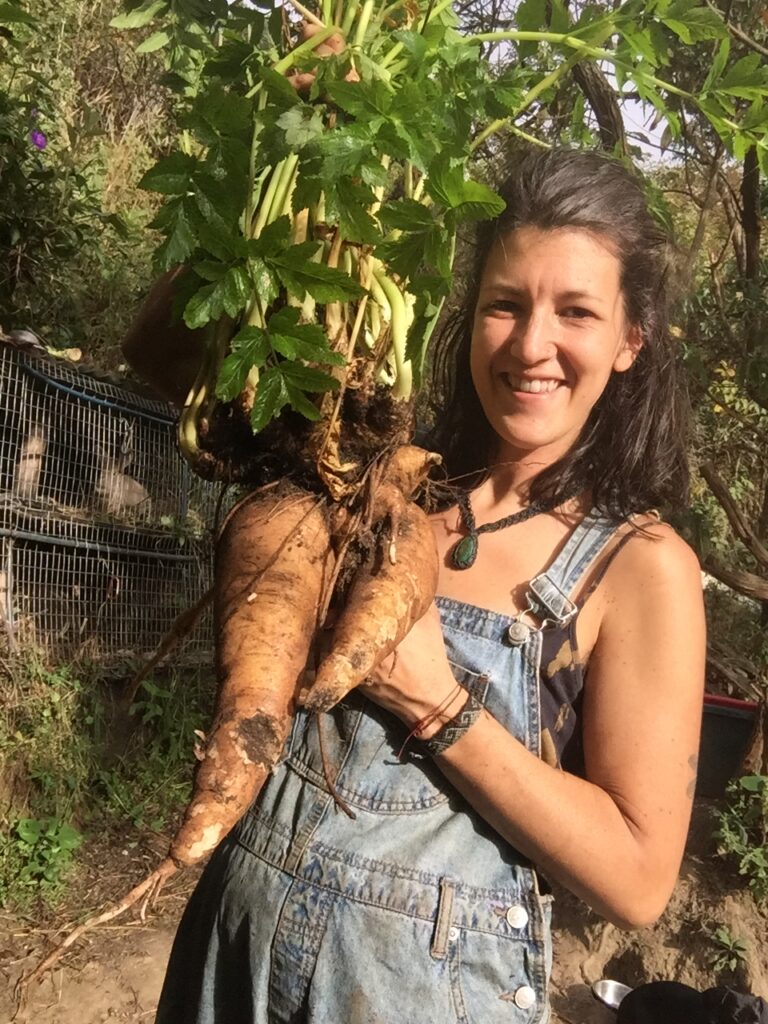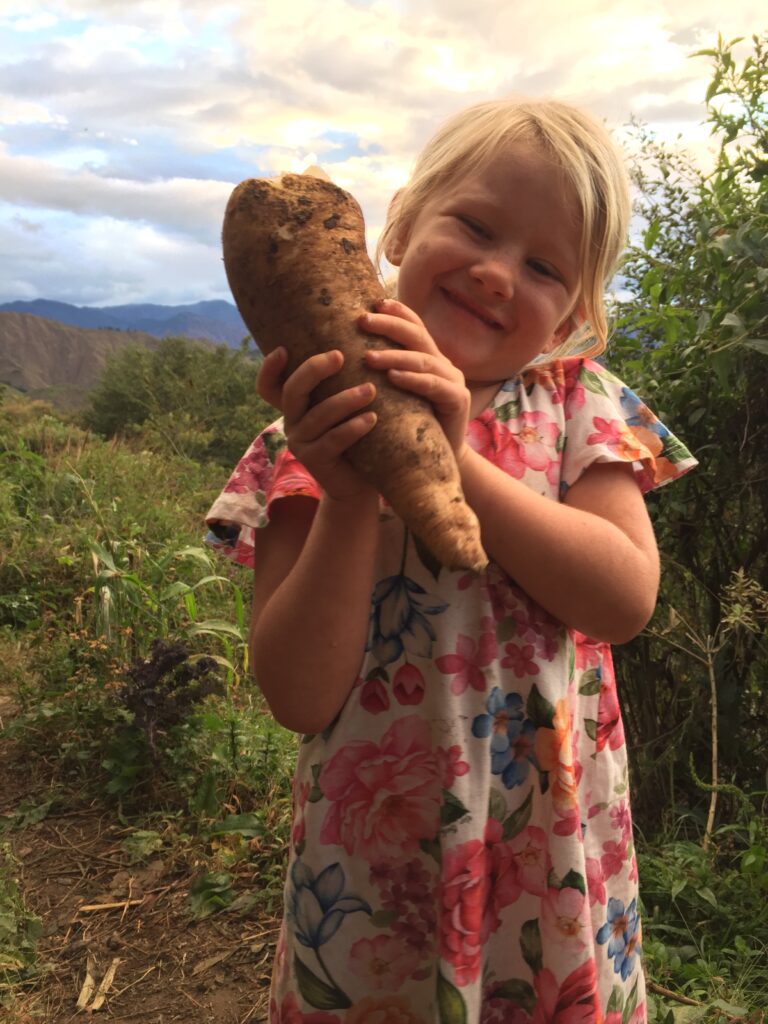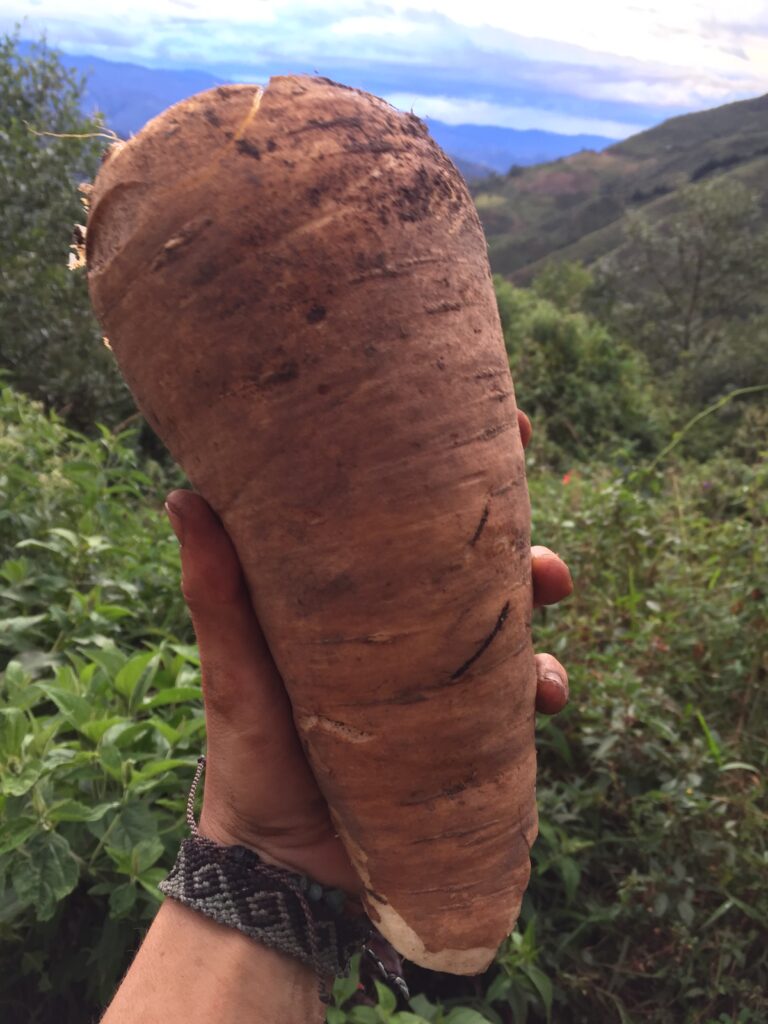Arracacha (Arracacia xanthorrhiza) is an Apiaceae family plant, also commonly known as Peruvian parsnip, apio criollo, zanahoria blanca, or white carrot. It produces fat whiteish roots that looks similar to a parsnip, with white, yellow, or purple flesh. The dark green, sometimes purplish, leaves look somewhat like parsley.
Arracacha is native to the Andean highlands of Bolivia, Colombia, Ecuador, and Peru. It can also be found growing in Brazil, Costa Rica, Cuba, Dominican Republic, Guatemala, Haiti, Honduras, Jamaica, and Puerto Rico.
The starchy roots of arracacha (ar-a-catch-a) are edible when cooked, and quite delicious. In fact, S.M. Bukasov, a well-known Soviet plant explorer in the 1920s, said “There’s nothing more tasty in the world than arracacha.” According to Lost Crops of the Incas, the flavor is a combination of celery, cabbage, and roasted chestnut.
The young stems are edible, as well. They can be blanched and used in salads or as a cooked vegetable. The central root stalk can also be eaten, though it is not as delicious as the lateral roots, and tends to be woody and strong flavored. Both the foliage and central root are fed to livestock.

Arracacha roots are typically harvested between 10-13 months after planting. Plants should be harvested before flowering or the roots will become fibrous and develop an unpleasant flavor. To harvest, the entire plant is uprooted. At this time, the smooth skinned lateral roots are set aside for eating and the crown can be divided & replanted to produce the next crop. Arracacha can be quite productive, producing yields of 2-3 kg (~4.5-6.5 lbs) of edible roots per plant. Yields will vary depending on the amount of moisture and nutrients in the soil. Roots have a short shelf life, for a root crop, and should be consumed fairly quickly after harvesting.
Plants generally prefer a temperature range of 14-21°C (~57-70°F). Lower temperatures may delay root development. Plants are not frost tolerant and additionally, seem to be unable to tolerate extended periods of temperatures above 25°C (77°F). Arracacha likes even moisture, but does not like to be water logged. Per Lost Crops of the Incas, plants prefer at least 1,000 mm (~39 in) of rain annually and “never less than 600 mm (~24 in) annually.” It has been cultivated from elevations of 600 m (~1,968 ft) or lower all the way up to 3,200 m (10,499 ft). Deep and well-draining sandy soils with pH 5-6 are thought to be ideal. Fertilizers with high nitrogen and low phosphorus content are said to increase yields (Lost Crops of the Incas 55).
Plants can be susceptible to viruses & bacterias, as well as nematodes and spider mites. Some varieties are more resilient to diseases and pests than others. Rats, snails, and root rot can also negatively affect yields.
Arracacha root can be boiled, baked, or fried. It should be peeled before cooking. It can be substituted for potato in most recipes, but has a richer, sweeter flavor. In Peruvian and Columbian cuisine, arracacha is a popular addition to cakes. One of our favorite ways to enjoy this tasty root is arracacha “french-fries.” It is also a great addition to any soup or stew, helping to thicken and adding depth of flavor. Another family favorite is arracacha mash. Our super simple recipe is detailed below.
Arracacha Mash
Peel roots and add to a pot of boiling water. Cook until soft. Strain the water and return the roots to the pot. Mash using a big wooden spoon or potato masher. Stir in salt to taste as well as a good glop of butter and a splash of milk or cream, if you like. Other optional additions: garlic, rosemary, thyme, oregano, black pepper, or tzintzo (an Andean herb).

The starches in arracacha roots are highly digestible. It provides essential nutrients, including potassium, iron, zinc, calcium, magnesium, copper, and boron. When compared to more well-known root crops, such as potatoes (Solanum tuberosum) and yams (Dioscorea alata), arrarcacha contains a higher concentration of important micronutrients, most notably iron and zinc (Choquechambi et al). Because it is soft, nutritious, and easy to digest, arracacha has been utilized as food for babies and the elderly.
In our gardens, arracacha grows without much maintenance. We typically plant it and more-or-less forget about it (aside from turning on the irrigation) until harvest time. We always have at least a few plants growing in various beds throughout the garden. Its delicious, nutrient dense roots make it one of our favorite Andean root crops.
References
“Arracacha.” Encyclopedia of Life. National Museum of Natural History. eol.org.
“Arracacha.” Lost Crops of the Incas. 47-55.
“Arracacia xanthorrhiza.” Plants of the World Online. Royal Botanic Gardens. www.plantsoftheworldonline.org
Choquechambi, Luz, et al. “Assessing the Nutritional Value of Root and Tuber Crops from Bolivia and Peru.” Foods. 2019 Nov; 8(11): 526.


